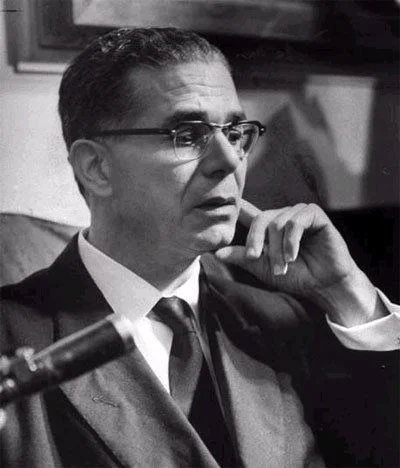By Amaury Rodríguez
November 16, 2018
Fourth in a series of articles that focus on research of Dominican history and society.
It’s fall and you want something real, exciting and worth pursuing. You are still in love. You want to move on from the traditional historical narrative. Moya Pons doesn’t matter anymore because in all truth, he never did. So you came up with some ideas, an outline of Dominican topics to pursue while flipping the bird o la gallina to all those who ignore your existence and that of others and guess what?
You know who you are!
Here are four research topics that we/you should pursue whether you are Dominican or not. ¿Vale? Here we go:
1
Architecture(s) of Counter-Revolution in Santo Domingo
Joaquín Balaguer. Source: Alchetron.
The terms architecture or architectures of counter-revolution might be useful to describe right wing policies of capitalist expansion that rolled back democratic gains after the defeat of the 1965 revolution in Santo Domingo by US military troops. With this defeat, a counter-revolutionary period led by Joaquín Balaguer emerged to the fore, normalizing state violence and repression in all its forms. Met with physical violence, however, dissidents fought back. With the blessing of conservative elites in Washington, the authoritarian counter-revolutionary state set out to implement reforms that soon redesigned the city, exacerbating the housing crisis. The re-organization of social relations within the capitalist framework had far-reaching consequences that eventually distorted the architectural physiognomy of the city and the nation as a whole as the state lacked a rational urban planning policy.
This is a study mainly inspired by the work of theoretician and urban planner Amparo Chantada. In it, researchers will further expand her work by looking at the transformations of the urban landscape in the Dominican Republic during the twelve-year regime under Balaguer, and recent attempts to turn the city of Santo Domingo into a «Nueva York Chiquito» [Little New York] by former president Leonel Fernández, one of the heirs of Balaguerismo. Areas of inquiry will deal with state investment on mega-projects, human displacement –from the interior to the city—corruption, foreign investment, various forms of environmental degradation and destruction, job precariousness and government neglect of city dwellers in both working class and middle class neighborhoods.
2
Calieses in Our Midst: Secret Police and Political Murder Under The Trujillo Regime
Calieses. Source: Historia Dominicana en Gráficas.
Inspired in part by the 1946 German film Die Mörder sind unter uns [Murderers Are Among Us] by director Wolfgang Staudte, this study is part of an ongoing series that will investigate the ramifications of political murder in Santo Domingo. The series will begin with a monographic study on the whereabouts, lives and transformations of state-paid snitches or informants (calieses) during the Trujillo dictatorship in the Dominican Republic.
Researchers will carry out an in-depth and thorough re-assessment of the post-dictatorial period and the subsequent failure to bring to justice collaborators of the regime.
The following are some of the questions that will aid in mapping this line of inquiry:
What was the role of gender, race and class in recruiting informants?
What intelligence and social repression systems serve as guidelines on which to model the Trujillo machinery of terror?
What mechanism were put into place by the Trujillo dictatorship to force calieses betray friends and family?
What internal conflicts developed among friends and family of informants?
Did informants feel any regret or remorse after sending anti-trujillist fighters—which included neighbors, friends and relatives—to torture chambers, work camps and ultimately, death?
3
From Red to Purple: Communists, Technocrats and The Frente Patriótico
How does one go from red (communist or left-wing) to purple (as in the color that represents the capitalist party Partido de la Liberacion Dominicana or PLD) in the Dominican Republic? Why did so many former communists—and fellow travelers—join the first government of Leonel Fernández from the PLD? Why did former revolutionaries betray their comrades, the working-class and their country by joining a conservative political project? What are some strong reasons why former revolutionaries hailing from various political strands and tendencies backed the first PLD government, a product of a right-wing alliance that orchestrated a repulsive racist campaign against José Francisco Peña Gómez, a black Dominican of Haitian descent? What led former anti-capitalists to embrace privatization of public goods (neoliberalism) and the free market after the end of the Cold War? How were former communists and fellow travelers able to reconcile their past radical politics with their newfound political (or apolitical) engagement? Also, how did former communist—some of whom had faced persecution and imprisonment by the right-wing forces they ended up backing—become avowed defenders of capitalism and the authoritarian state?
These and more are some of the questions that researchers could elaborate as part of a study on the personal and political transformation undergone by intellectuals and militants who at one point of their lives identified with left-wing politics in the decades of the 50s, 60s and 70s. The backdrop of these political transformations were the crisis of the international left which accelerated with the fall of the Berlin Wall in 1989 and the eventual disintegration of communist regimes in the former Soviet Union and Eastern Europe. Researchers will look at the aforementioned questions and the impact of the fall of communist regimes and the Soviet Union as well as defeats of guerrillas in Central American and other parts of the world.
___
Related articles
Ten Research Ideas About Dominicans That You Should Pursue (Part 1)
Fifteen Research Ideas About Dominicans That You Should Pursue (Part 2)
Eight Research Ideas about Dominicans That You Should Pursue (Part 3)
Send any feedback to esendom@esendom.com


